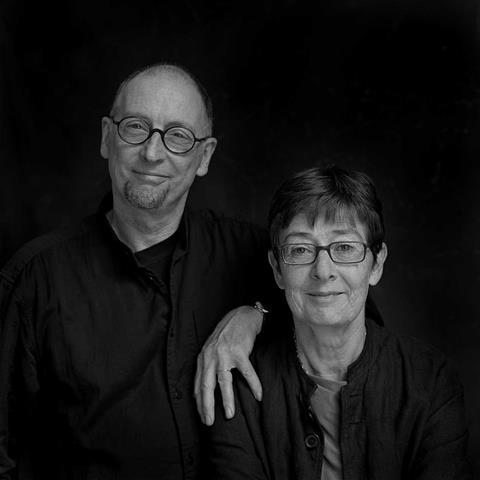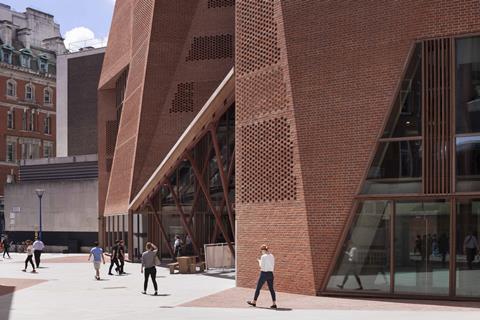Irish architects Sheila O’Donnell and John Tuomey will receive prize next February
Irish architects Sheila O’Donnell and John Tuomey have been named as the 2015 recipients of the Royal Gold Medal.
The pair founded their Dublin-based practice O’Donnell & Tuomey in 1988, having previously worked together for Stirling Wilford Associates and Colquhoun & Miller in London.
The practice has been shortlisted for this year’s Stirling Prize with its Saw Swee Hock Student Centre for the London School of Economics the bookies’ favourite for this year’s award due to be announced next month.

The firm has never picked up the prize despite four previous nominations, with the LSE scheme its third in four years. Its previous nominations include the Lyric Theatre in Belfast and the An Gaeláras Irish Language Arts and Cultural Centre in Derry.
Receiving the award, the pair said: “We’re delighted to have been chosen for this unexpected honour. We’re humbled to find ourselves in such a company of heroes, architects whose work we have studied and from whose example we continue to learn.
“We believe in the social value and the poetic purpose of architecture and the gold medal encourages us to prevail in this most privileged and complicated career.”
Previous winners of the medal, which has been awarded since 1848, have included Frank Lloyd Wright, Norman Foster and last year’s recipient Joseph Rykwert.
RIBA president Stephen Hodder said: “O’Donnell & Tuomey’s work is always inventive – striking yet so well considered, particular to its place and brief, beautifully crafted – and ever developing.
“It is an absolute joy and inspiration to hear them describe their work, and always a delight to experience one of their buildings. Sheila and John are at the vanguard of contemporary Irish architecture and I am delighted they are to receive this lifetime honour.”
They have exhibited three times at the Venice Architecture Biennale and are both alumni of the School of Architecture at University College Dublin where they continue to teach and inspire the next generation of architects.
The pair will be presented with the medal at the RIBA in London next February.
Citation for Sheila O’Donnell and John Tuomey
Joseph Rykwert writes:
In presenting the Royal Gold Medal to Sheila O’Donnell and John Tuomey, I am conscious that they are among the youngest recipients of the Medal, and moreover that it is forty years since it had been awarded to an Irish practice. In the meanwhile Irish architecture has flourished - particularly in their generation - with a commitment to the art and the craft of building which is the envy of our more populous island.
What marks Sheila O’Donnell and John Tuomey’s achievement is that very commitment. They are, of course, builders first of all: but they are writers and teachers as well as professionals, active through the Architectural Association of Ireland in whose recent revival they were instrumental, so that their presence on the Irish scene is a powerful one, and their influence as teachers and writers has been extremely important.
Their connection to London and the London scene began when they worked for Stirling and Wilford and then for Colquhoun and Miller; but their first contribution in their own right was the modest but brilliant Photographers’ Gallery in Soho, and it was later asserted much more visibly by the - now celebrated - Saw Swee Hock Student Centre for the London School of Economics, a work of unique architectural distinction for that august institution, and a commission which they won against very stiff competition.
The LSE Student House is visible from Kingsway and Lincoln’s Inn Fields - which makes it a very public building indeed. Its formal brilliance is enhanced by the skilful use of brick which sets up a dialogue between the calm, almost reassuring surface and the exhilarating dynamic of the volume that it encloses.
Despite this formal brilliance, the architects’ commitment to ecological parsimony remains a constant of all their work. In shortlisting the building for the 2014 RIBA Stirling Prize the judges said, ‘In the midst of a complex mediaeval London street pattern O’Donnell and Tuomey have woven a little of their magic. This remarkable project is an object lesson in mobilising the limitations of a site into a startlingly original building which makes a massive contribution to its townscape.’
Brilliance marks their Lyric Theatre in Belfast as well; again the almost commonplace brick surface links it to its surroundings, and is in dialogue with the inviting intricacy of a complex but easily accessible public building, elegantly sited to form an angle with the embankment of the Lagan river.
I have chosen to mention these buildings partly because they are of all their works the most familiar to me, but also because they represent the range of their activity as well as its character and show an inspired response to a complex brief. The practice began, as is usual, with a miscellany of work: the Dublin film and photography commissions, a golf course in County Down and a private house in Navan. More houses followed, in Howth and Killiney, but soon John and Sheila were working on schools (the Ranelagh Multi-Denominational School and Cherry Orchard School, both in Dublin) public housing (Galbally village extension and Timberyard Social Housing, Dublin), and community buildings (the Sean O’Casey Community Centre, Dublin – both these latter two shortlisted for the RIBA Lubetkin Prize) and An Gaeláras Irish Language and Cultural Centre in Derry.
They are vitally concerned with building in the public realm, something so neglected today, and that is perhaps their greatest strength. The other important element seems to me just as crucial, and it is seen in the dialogic character of their activities. The conversation is first of all between the two of them, but it asserts itself equally in their work from the outset, so that the interpretation of their clients’ needs becomes the dominant, the directing motif of the design, and remains characteristic of the much more complex recent buildings, where - as in the very intricate LSE centre - the visitor’s path turns into a magnificent reading of the functional variations.
They have at no point rested on their laurels - nor are they likely to do so. I therefore look forward to many buildings of equally, even ever greater challenging excellence.

Niall McLaughlin writes:
When the death of Ronnie Tallon in June (2014), I realised that he was Ireland’s last surviving contact with the Royal Gold Medal. The period since the award to Michael Scott in 1975 (the only other Irish recipient being that engineer and citizen of the world Peter Rice), has been very productive for Irish architecture and one can think of many distinguished practices that have developed there during the extraordinary boom in construction between 1995 and 2008, including Heneghan Peng and Grafton Architects. Their reputations will grow in Britain over the next few years, but I do think that the Irish practice with the most significant influence over the last two decades has been O’Donnell & Tuomey.
Having studied in Dublin, Sheila and John earned their spurs working in London for Stirling Wilford Associates and Colquhoun & Miller. Sheila studied with Edward Jones at the RCA and brought some of that mind-set back to Dublin on her return. Their decision to come back to Ireland in the economic desert of 1981 cannot have been easily taken.
As a student, I remember hearing their declared intention to forge a new Irish architectural identity. They did this through publications, through teaching and through their involvement in initiatives like Group ’91, a collaborative effort to design a whole street in the manner of La Strada Novissima. The combination of Sheila’s quiet, studied Rationalism and John’s fluent, rhetorical Constructivism quickly made its mark.
Over three decades, their work developed from mannered neo-classicism in the European vein to a highly crafted low-tech vernacular, through to a boisterous Constructivism. Their work is evolving and open to experiment, with the best individual projects coming as quieter reflections on their noisier ideas.
For me, the Irish Film Centre, the Dublin Photography School, The Irish Pavilion at IMMA, The Furniture College at Letterfrack, The Dalkey House, The Irish Language Cultural Centre, Timberyard Housing and the LSE are excellent projects; the Lyric Theatre and the Glucksman Galley in Cork are truly exceptional. Of the gallery the Stirling judges stated, ‘This building belongs to the canon of modern buildings. Miles Davis once said that what most artists do is to make simple things complex, but what great artists (and of course that included him) do is to make complex things appear simple. This is one of those rare buildings that fits that definition of greatness.’ In all they have been shortlisted for the Stirling Prize no fewer than five times. Throughout their work we see a restless invention and a desire to develop beyond what they know. Sheila’s mind always returns to Terragni and the underlying order; John’s mercurial heart goes with Stirling, to mannerisms, paradoxes, collisions and irresolvable positions. We see in their best work a playing out between the desire for harmony and the pleasures of dissonance.
The Royal Gold Medal recognises influence as well as skill. It is worth remembering the great contribution made to the evolving movement for the regeneration of inner cities made by Group ’91 when they won the competition for the renewal of the Temple Bar quarter of Dublin City Centre. It was an extraordinary collective enterprise that invited the concept of a structured collaboration between smaller practices to create a coherent urban realm from dilapidated building stock. Between new squares, bistros and an open-air cinema, we hardly knew ourselves! It was a very successful project for the city and this quarter continues to thrive and develop today.
O’Donnell & Tuomey have taught regularly throughout their careers. I remember them coming to University College Dublin in 1982 like two firebrands. They inspired us. They seem to have had the same impact on the recent graduates I see coming to my office now. That is a sustained and powerful influence over 30 years. John Tuomey also writes books that are quietly understated and that give little away about his protean design spirit. They have exhibited beautifully three times at Venice, the Biennales of the 2004, 2008 and 2012.
I recommend them because they give witness to architecture as a lifetime’s pursuit. In their buildings, teaching, writing, drawing and rhetoric they tell us all how to be architects. Everything they do speaks to the best of us.
Source
This story originally appeared on ��ɫ����TV Design .



























No comments yet